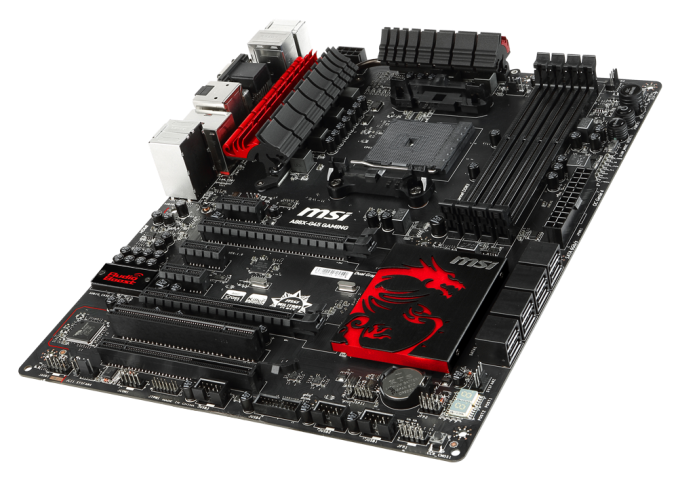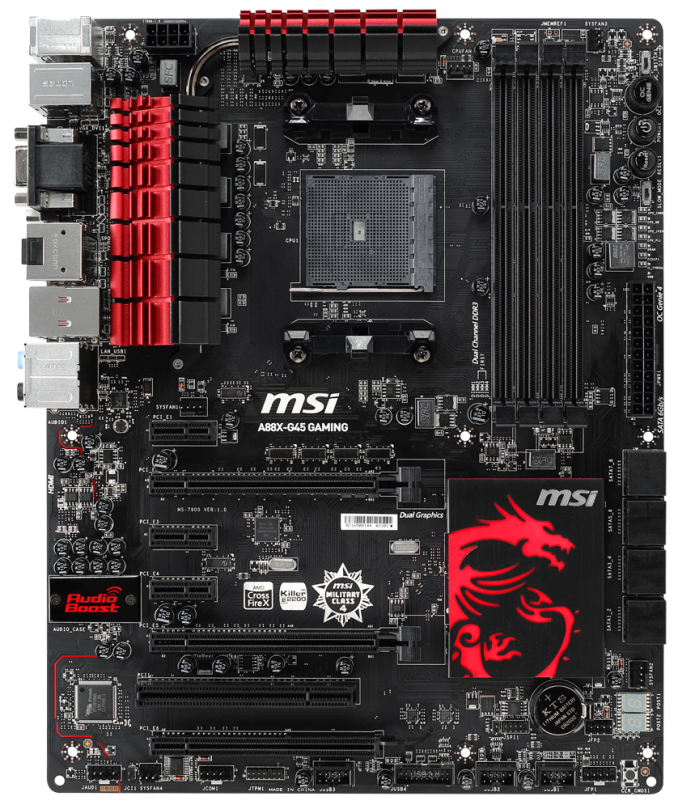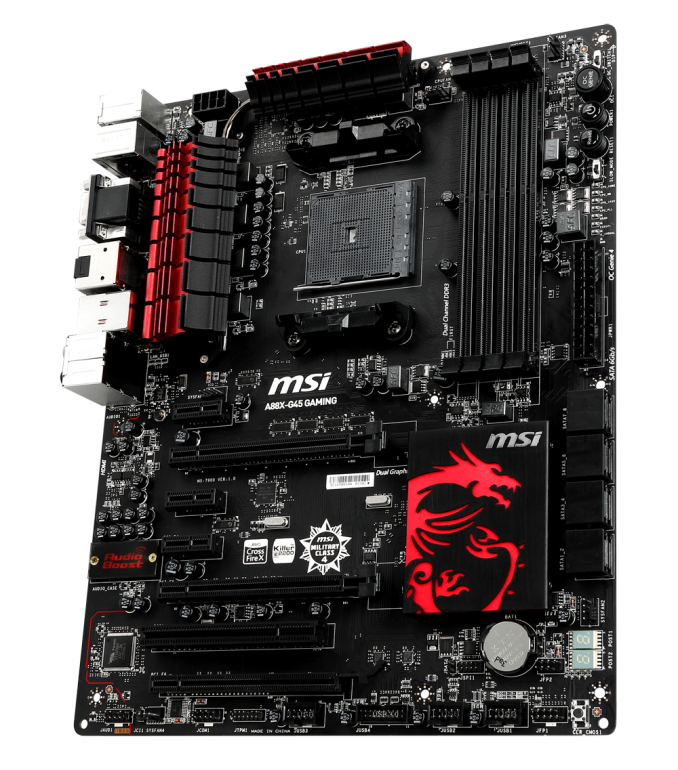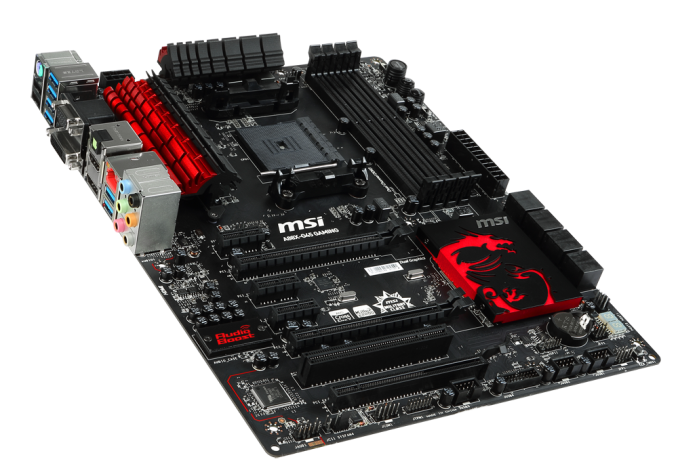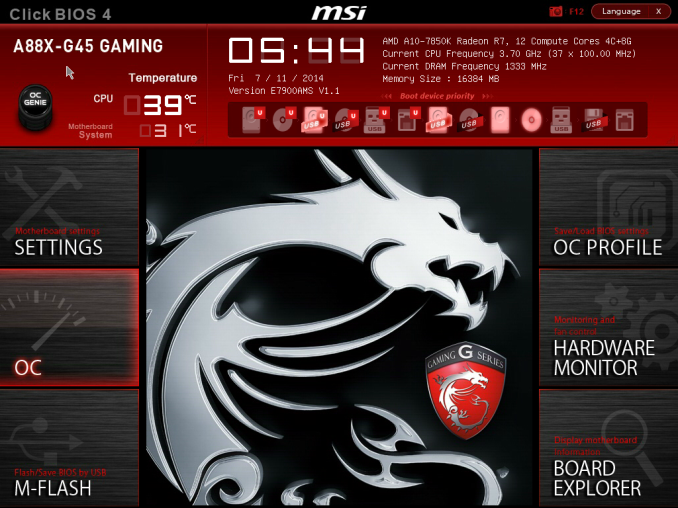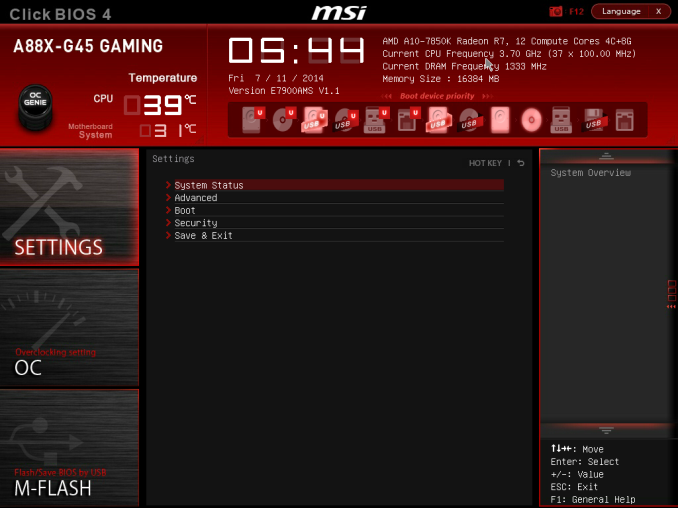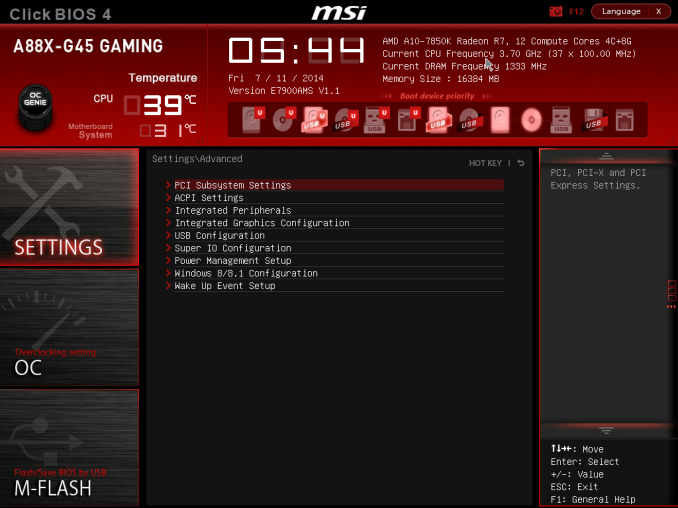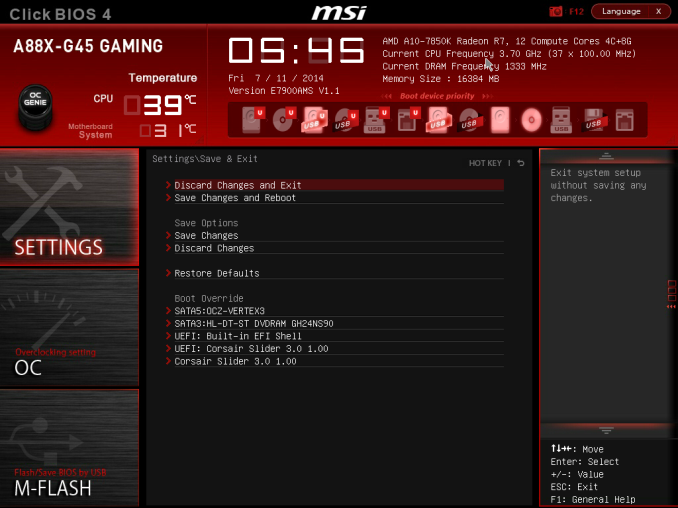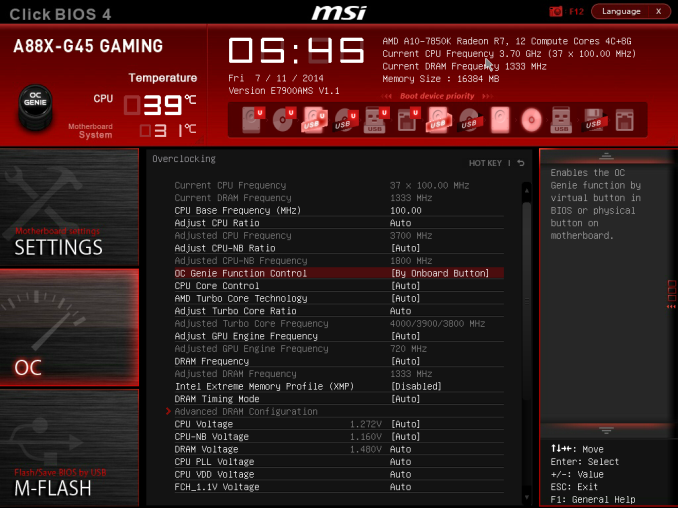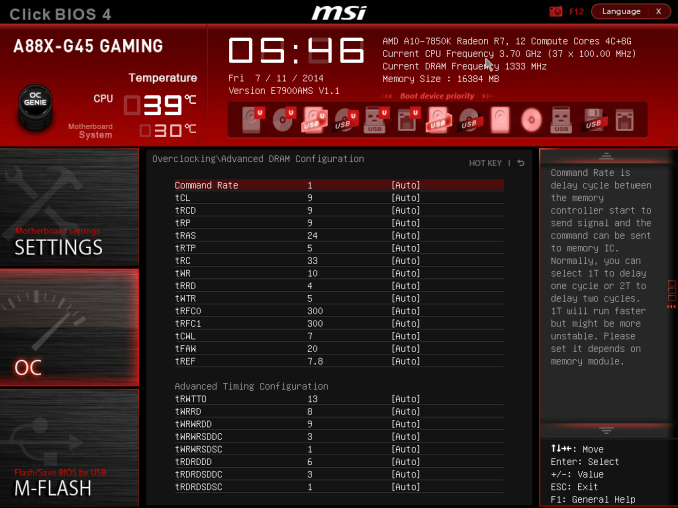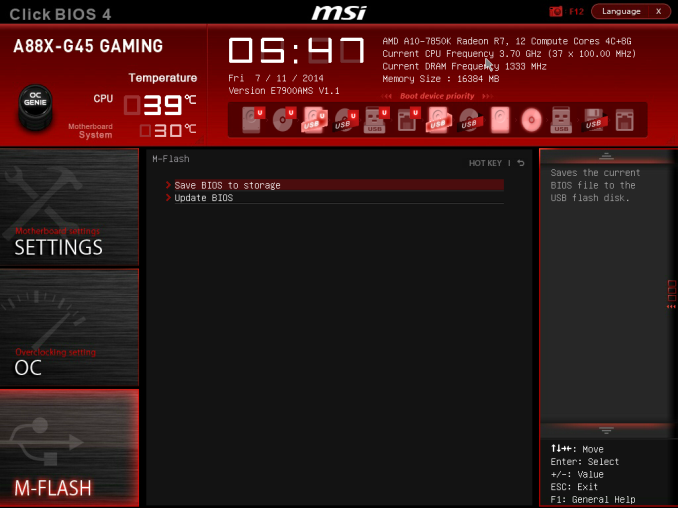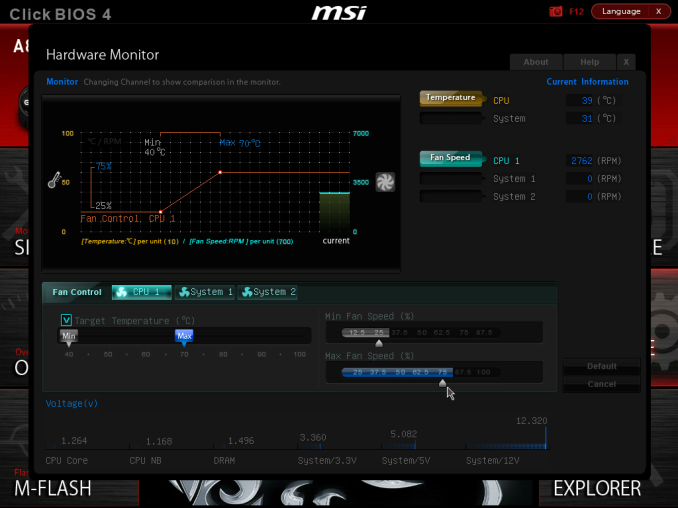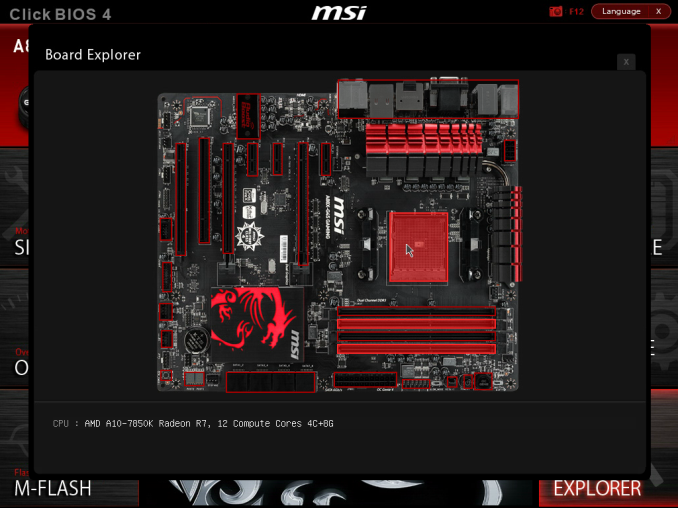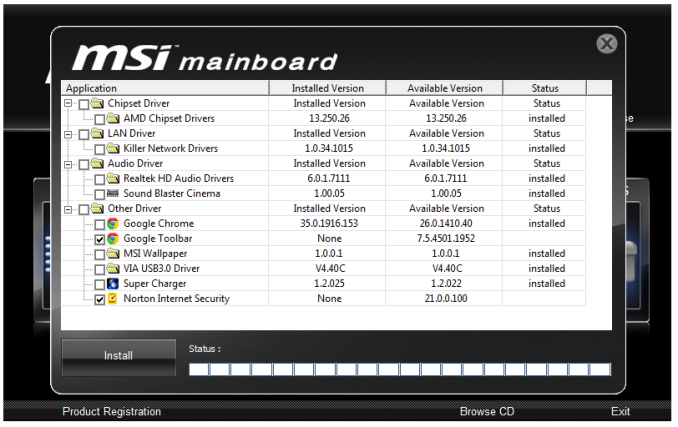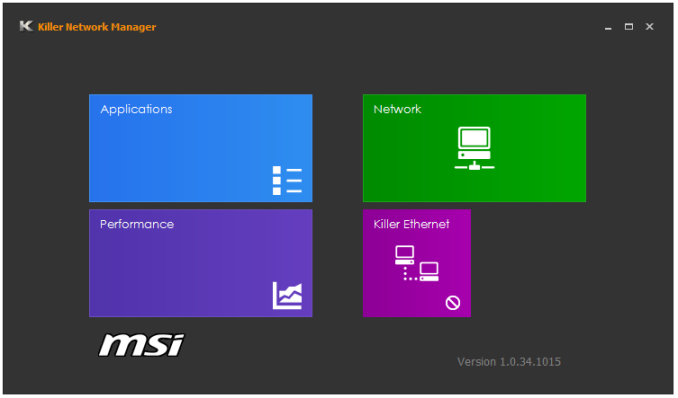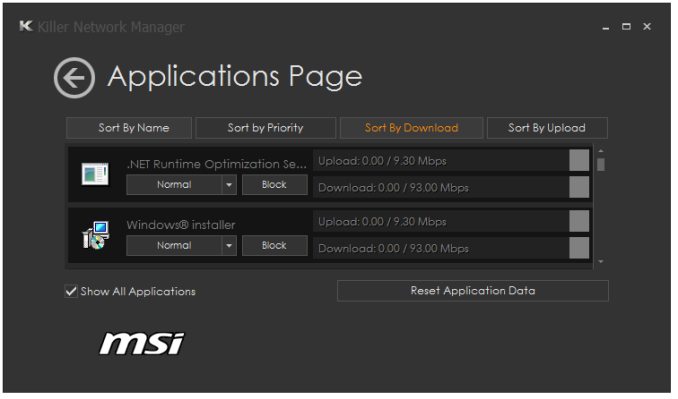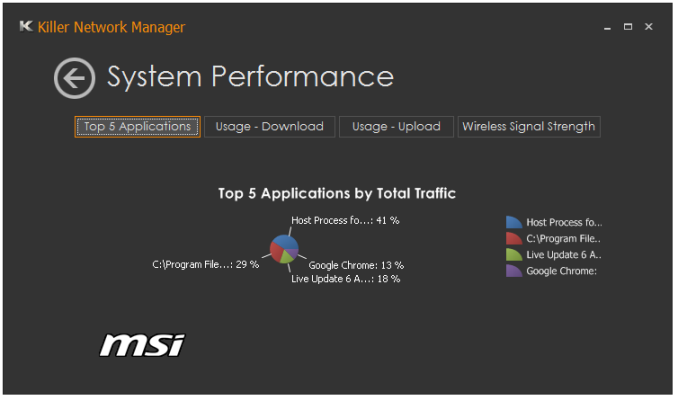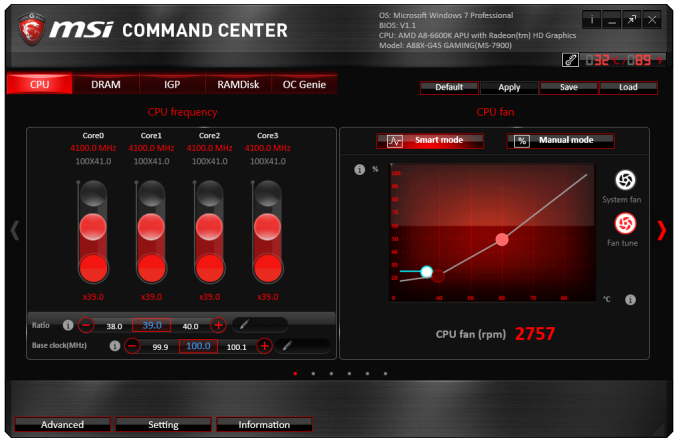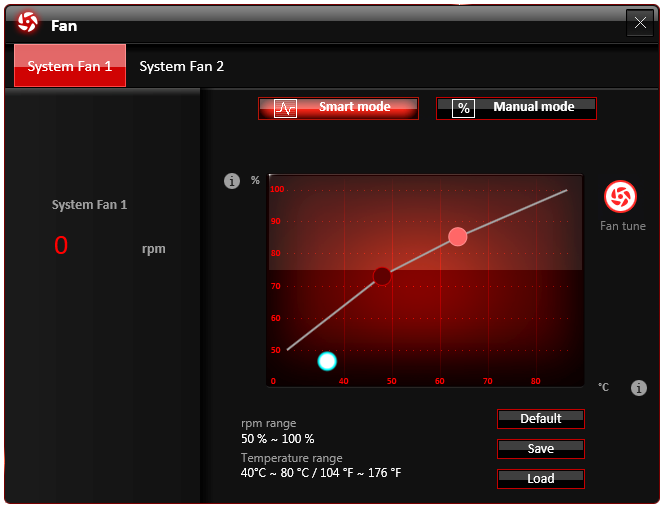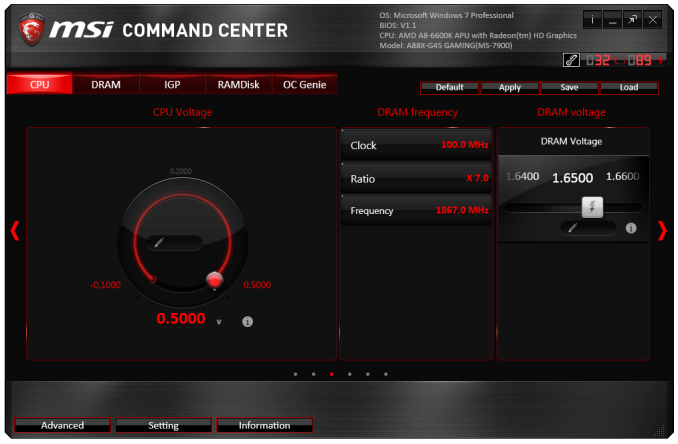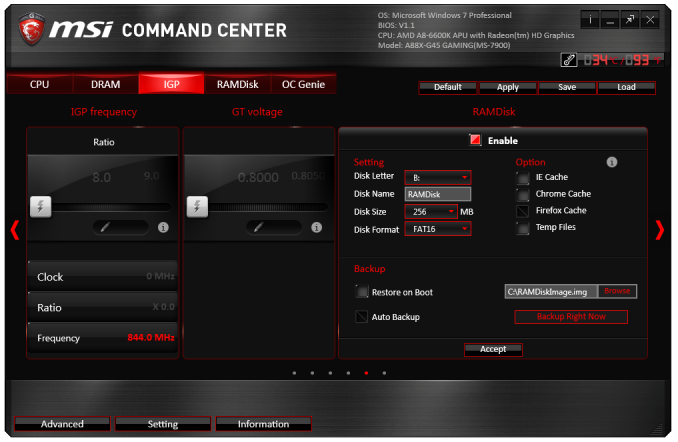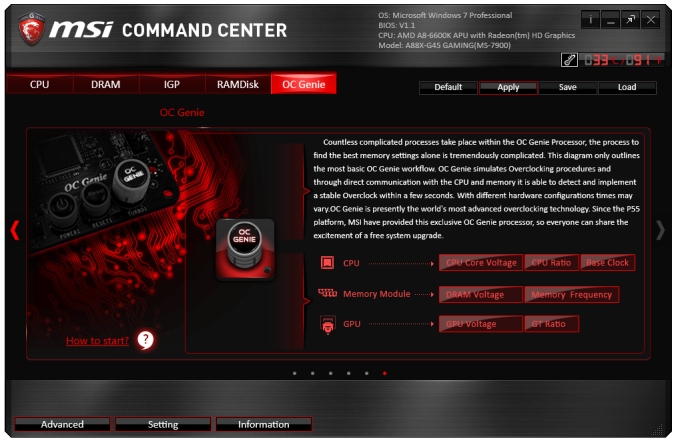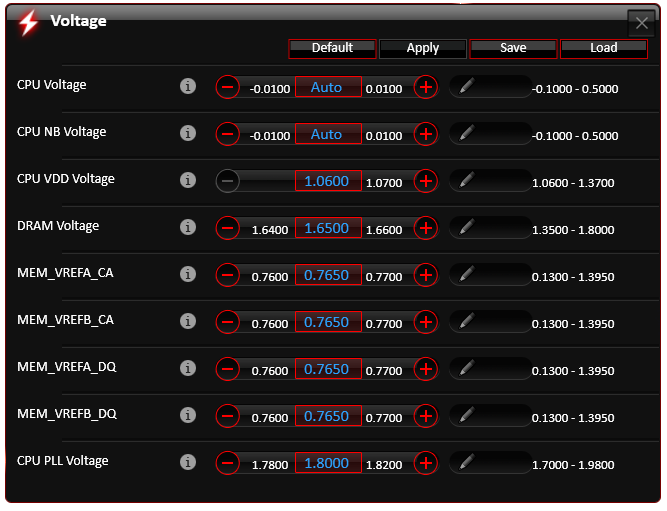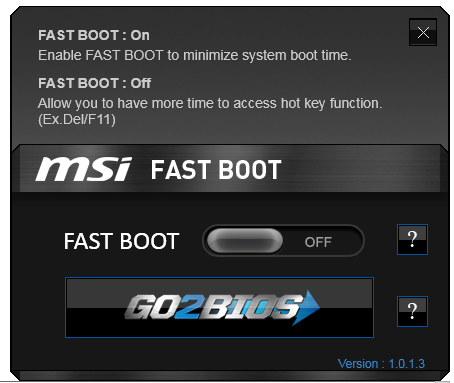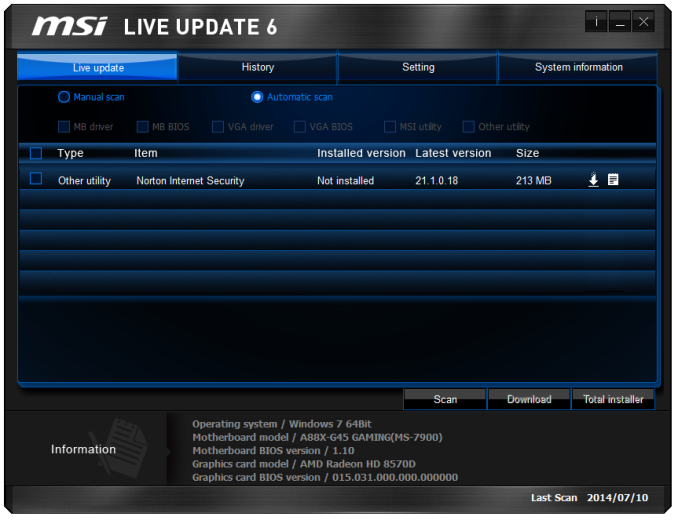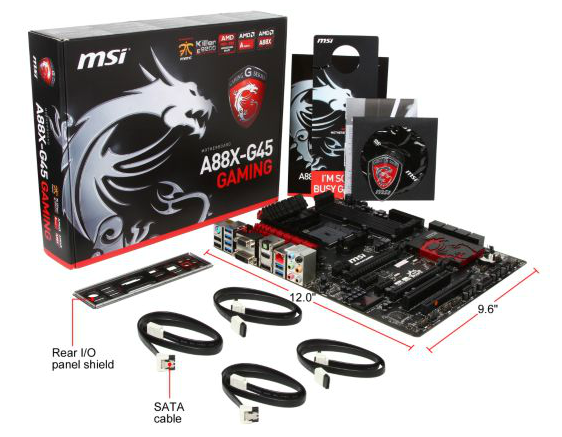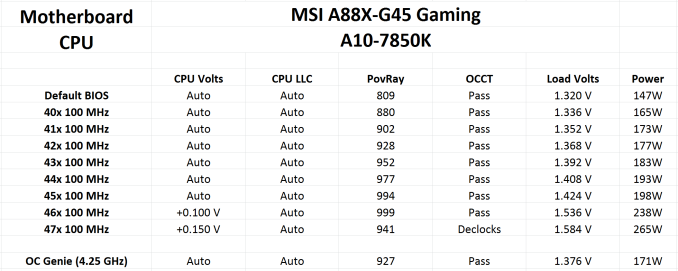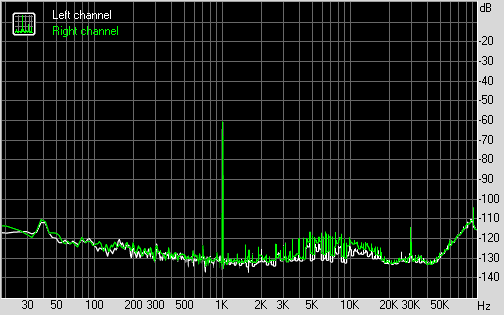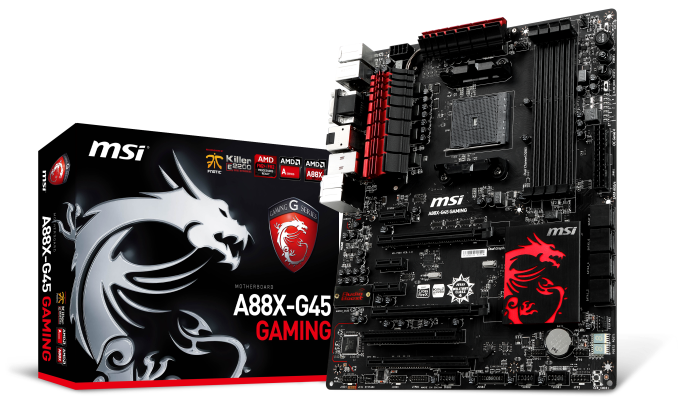
Original Link: https://www.anandtech.com/show/8351/msi-a88xg45-gaming-review
MSI A88X-G45 Gaming Review
by Ian Cutress on August 11, 2014 8:00 AM EST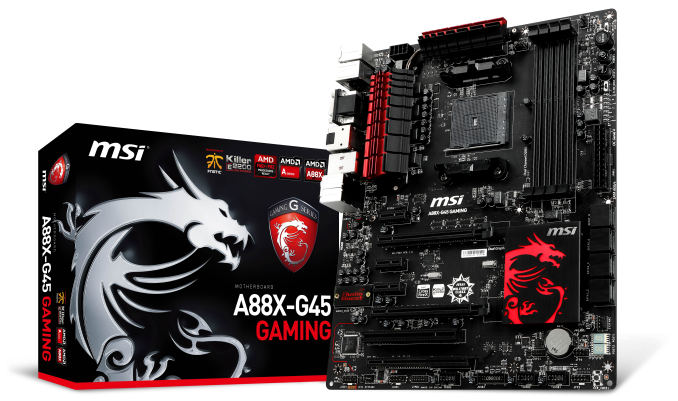
One of AMD’s main selling points it likes to promote is towards the gamer, especially those on a tighter budget. This subsequently suggests to the motherboard manufacturers to build models oriented for gaming. MSI’s Gaming Range has become a solid part of MSI’s plethora of motherboards, and now this extends to the FM2+ platform. Today we review the MSI A88X-G45 Gaming.
MSI A88X-G45 Gaming Overview
One might suspect that the concept of discrete GPU gaming goes against the purpose of the AMD FM2+ platform. Here is a socket and chipset designed for an APU that is optimized for its integrated graphics, so why would a user purchase such an APU and then disable access by adding a discrete GPU? Or use a motherboard with the APU and then use two graphics cards in Crossfire? One could argue that if the motherboard is used in dual graphics mode with another PCIe card (RAID, Sound Card, FPGA) that this is the optimal scenario. So why would such a motherboard be advertised as supporting 2x and 3x Crossfire with discrete graphics cards? The answer is simply ‘because it can’ and ‘performance with a high end APU with discrete graphics is still pretty good’. We could also argue the cost route – investing in a quad thread, overclockable AMD APU is cheaper than the competition.
At $119, this is clearly where MSI is aiming with the A88X-G45 Gaming. The low cost, gaming oriented product is promoted as supporting multi-GPU gaming with AMD graphics cards while also sporting several gaming features. MSI loves the Killer networking interface range, and as such the E2200 series NIC is implemented, along with software to manage the priority of any program or game that needs network connectivity. There is also a high-polling USB 2.0 port, enhanced Realtek ALC1150 audio with Sound Blaster licensing and a Gaming Series stick-on badge in the box.
Other features on the motherboard include a one-button overclock with two modes, fan profile control via the BIOS or the provided software, and stabilized 5V USB power to minimize power jitter to signal sensitive USB devices. The motherboard has eight USB 3.0 ports in total, two via a header and six on the rear, with some of these on the rear coming from a VIA VL805 controller. There are also eight SATA 6 Gbps ports and a TPM header.
Despite the motherboard having five fan headers, the built in software only allowed control of two plus the CPU header. The fan control software for MSI, as mentioned in recent MSI reviews, has improved especially in the BIOS with a more detailed adjustment system. Overclocking on MSI’s FM2+ system is via the BIOS and software, but only allows CPU voltage adjustment in terms of an offset rather than an absolute value. Neither of these issues is critical in terms of operation. Unfortunately the easy XMP enable of MSI’s 9-series is not here.
Overclocking performance gave us 4.5 GHz on our A10-7850K, with any more frequency requiring voltage that caused the system to reduce frequencies under load. Compared to some of our previous A88X reviews, this is actually a rather good overclock. Automatic overclocking gave a good leap to 4.25 GHz and a 15% gain in POV-Ray performance.
The shining light in the performance of the MSI A88X-G45 Gaming, perhaps ironically enough, is the gaming. Frame rates with a discrete graphics card for all our games were near the top or exceeding some of the previous best using the A10-7850K APU. The CPU performance by comparison was below average when directly comparing to other A88X motherboards; some benchmarks were either first or second, although the majority were in the bottom half.
System performance has longer POST times than most at 15+ seconds, and audio performance for the codec used is towards the lower end of our testing. Power consumption is some of the best A88X we have seen, showing under 150W with an OCCT load, compared to the 150W+ of many of the other motherboards.
Visual Inspection
As with most of MSI’s new range of gaming motherboards, the red and black livery is often the first thing noticed and remarked upon. Since introducing their dragon themed gaming series, MSI has indicated that sales are up and its users are pleased. While it might not be to everyone’s taste, and as users have remarked in the past ‘what use is styling when no-one is going to see it’, good aesthetics are always a positive in our reviews. It shows effort on presentation, and indicating that buying such a product is an experience more than a function.
On the motherboard, the two power delivery heatsinks around the socket are joined by a heatpipe, with several fins on the heatsinks to help add surface area for cooling. Due to the rectangular nature of the AMD socket, we seem to be up against the AMD specifications at the top of the motherboard, but with more space on the other three sides for coolers. Users with all DRAM will have to orient non-square heatsinks appropriately to avoid conflict. In the socket area there are three fan headers within easy reach – the four pin CPU fan header above the socket, a 3-pin SYS header to the top right beyond the DRAM slots and a 4-pin SYS header just above the first PCIe 2.0 x1 slot. The other two fan headers are located at the bottom of the board.
The DRAM sockets are in plain black, and use latches on both sides rather than single sided latches, presumably because the first GPU slot is the second PCIe slot on the motherboard. There is a handy diagram on the motherboard, to the bottom left of the DRAM slots, to show which slots should be populated first.
On the top right of the motherboard are a number of MSI’s extra features. First is the OC Genie Switch which adjusts the severity of the OC Genie overclock which is enabled by the OC Genie button underneath the switch. Below the power and reset buttons is a slow mode switch that forces the motherboard into running at idle speeds regardless of the CPU load. This is primarily used by overclockers to get stability after a benchmark run. Underneath this switch is a series of lights indicating what stage of the POST process is being run, and can be useful for diagnosing POST issues.
Further down the right hand side is the 24-pin ATX power connector, followed by eight SATA 6 Gbps ports all provided by the A88X chipset. The chipset is underneath the dragon heatsink to the left of the SATA ports. At the bottom right of the motherboard is the two-digit debug display, a 4-pin SYS fan header, the USB 2.0 and USB 3.0 headers, a ClearCMOS button and the front panel headers. One of my recent criticisms of MSI motherboards is that the front panel header is not labelled with what pins are for which connection, regardless of any aids in the box. It should, ideally, be a fundamental part of any motherboard.
The bottom of the motherboard also has a TPM header, the COM header, another fan header (3-pin) and the front panel audio header. The audio system is controlled via the Realtek ALC1150 audio codec which MSI has placed under an EMI shield. The motherboard also uses additional filter caps for the rear audio and PCB separation to improve the audio signal by minimizing interference from digital traces.
The PCIe slots are designed primarily for one or two large PCIe devices, although three AMD GPUs can be used in an x8/x8 + x4 configuration. Like all FM2+ motherboards, there is no SLI certification. There is also a PCI slot for legacy cards as well as several PCIe 2.0 x1 cards for extra features.
The rear panel has six USB 3.0 ports altogether, some provided by the chipset and others through a VIA VL805 controller. The rear panel also has two USB 2.0 ports, a combination PS/2 port, a quartet of standard video connectors, the Killer NIC port and gold lined audio jacks as part of the upgraded ALC1150 audio system.
Board Features
| MSI A88X-G45 Gaming | |
| Price | US (Newegg) |
| Size | ATX |
| CPU Interface | FM2+ |
| Chipset | AMD A88X |
| Memory Slots |
Four DDR3 DIMM slots supporting up to 64 GB Up to Dual Channel, 1333-2400 MHz |
| Video Outputs |
VGA (1920x1200 at 60 Hz) DVI-D (2560x1600 at 60 Hz) HDMI (3840x2160 at 30 Hz or 1920x1200 at 120 Hz) DisplayPort (4096x2160 at 24 Hz) |
| Onboard LAN | Qualcomm Atheros Killer E2205 |
| Onboard Audio | Realtek ALC1150 |
| Expansion Slots |
2 x PCIe 3.0 x16 (x16/- or x8/x8) 1 x PCIe 2.0 x4 3 x PCIe 2.0 x1 1 x PCI |
| Onboard SATA/RAID | 8 x SATA 6 Gbps (A88X), RAID 0,1,5,10 |
| USB 3.0 |
4 x USB 3.0 (A88X) [2 rear panel, 1 header] 4 x USB 3.0 (VIA VL805) [4 rear panel] |
| Onboard |
8 x SATA 6 Gbps 1 x USB 3.0 Header 3 x USB 2.0 Headers 5 x Fan Headers 1 x TPM Header 1 x COM Header Power/Reset Buttons OC Genie Button Front Panel Connector Front Audio Connector 2-digit Debug ClearCMOS Jumper OC Genie Switch Slow Mode Switch |
| Power Connectors |
1 x 24-pin ATX 1 x 8-pin CPU |
| Fan Headers |
1 x CPU (4-pin) 4 x SYS (2x 4-pin, 2x 3-pin) |
| IO Panel |
1 x PS/2 Combination Port 2 x USB 2.0 2 x USB 3.0 (A88X) 4 x USB 3.0 (VIA) VGA HDMI DVI-D DIsplayPort 1 x Network Port (Killer E2205) Audio Jacks (ALC1150) |
| Warranty Period | 3 Years |
| Product Page | Link |
The use of a Killer NIC gives MSI access to software that controls program optimization of the network stack. As this is the E2205, this is solely a software implementation similar to others used on other motherboards with licensed software but with the Killer branding oriented towards gaming. MSI also states that the USB 2.0 ports are Gaming ports, capable of up to 1000 Hz response, although there is no software to confirm this and I do not own a high polling capable mouse to test.
MSI A88X-G45 Gaming BIOS
Having dealt with MSI’s upgraded Z97 BIOS for a couple of recent reviews, taking a step back to the older version of the BIOS shows how a couple of simple upgrades can make all the difference. The A88X BIOS falls behind the Z97 BIOS on several key features: ordered overclocking options, no XMP button and simplified fan controls.
The first thing a user sees when entering the BIOS is this large dragon motif. This main screen lists the CPU installed, the CPU frequency, DRAM frequency, DRAM size and BIOS version. The motherboard name is also here, with CPU and system temperatures. This is a persistent banner, but is missing a couple of bits of information I would find also relevant: fan speeds and CPU voltages.
This main screen uses the six options down the sides for the other menus:
The Settings tab holds the Advanced menu option that opens up most of the controller options for the motherboard:
The Advanced menu hides nothing we have not seen before. One potential option I would like to see in future is an ‘extreme’ option that disables all non-essential parts of the BIOS (audio, NIC) for users that want a stripped out system.
The Save and Exit menu holds the one-time Boot Override options, useful for installing an OS via USB or booting from a different device.
The overclocking menu is essentially a mélange of options with no real order. MSI has worked on this for Z97, but has not retroactively applied it to the FM2+ series as of yet. I feel that we might have to wait until the next AMD update to see that order. Nevertheless, the key options regarding CPU ratios, XMP and CPU voltages are here. One point worth noting is that MSI does not support absolute CPU voltage settings on this motherboard, and users can only select an offset. I registered my disappointment with MSI on this detail, and they described the decision as a design choice.
The DRAM configuration lists the current settings of the memory, along with a description of each option on the right hand side. I would also like to see the XMP setting if available in this menu.
Updating the BIOS is done via the M-Flash menu. Note that the system might restart in order to update parts of the BIOS, and it is vital to let these run and not try to reset the system mid-flash. I mistakenly tried to reset mid-flash when nothing appeared on my screen – not a good idea, as it turns out my monitor was being slow to show a screen.
For fan controls, the Hardware Monitor tab on the main page opens up the screen above. The user can control the 4-pin fan headers on the motherboard, and specify the minimum/maximum power applied (note, not speed as written above!) to the fan. This is the type of graphical representation for fan controls that I have asked motherboard manufacturers to add since the beginning of graphical interfaces in the BIOS. Although this one gets some of the physics wrong, it was definitely a step in the right direction when MSI first introduced it. The Z97 chipset improvement has a few more interactive features, showing evolution of the idea.
Board Explorer is becoming a staple across almost all the motherboard manufacturers, showing what hardware is installed and what it is detected as. I recently used this exact feature to diagnose a new SATA drive that was DOA, but another use can be to detect which memory stick is ill.
MSI A88X-G45 Gaming Software
MSI’s driver DVD has a neat trick that as far as I can remember, no-one else does. If your screen resolution is too small to fit the installation interface, it will attempt to adjust the resolution of the screen to compensate. This helps me a great deal when setting up a motherboard for review, as I typically install the chipset drivers before any graphics drivers.
I will land one significant critique at MSI, as I do with other motherboard manufacturers. Please stop auto-including ant-virus and firewall programs with the software on the DVD. It subsequently becomes a part of the auto-update software and stays there ad-infinitum. I understand that these companies might invest some money in order to be included, but I would much prefer a separate DVD to be included with solely that software. That way I can remove it from my premises via some bonfire or clay pigeon launcher and choose my own anti-virus to install.
Killer Network Manager
Because MSI is marketing a gaming oriented motherboard, the extra gaming controllers also have their own software. In this case we get the Killer Network Manager for network management.
This software comes part of the package that MSI purchases, and uses a Windows 8 style interface. The basic premise is the ability to give each program a priority level for network traffic:
The software intercepts network traffic before it hits the Windows stack and reorders it appropriately, sending a series of packets for the most important software at a time. One would assume that using their own hardware, this could be implemented at the hardware level, but Atheros now do everything in the software. So one can surmise that because MSI buys the Killer NICs in bulk (for motherboards and laptops), it ends up being more cost effective than a Realtek/Intel + cFos implementation.
The software also monitors performance and usage:
MSI Command Center
The main hub of MSI’s options is with Command Center.
At the front of the software we get the motherboard model name, BIOS version, CPU used and OS, all of which is good information to receive. The Command Center interfaces uses a sliding system starting with basic CPU frequency overclock options and fan controls. The fans can be placed in a smart mode which allows a two-point gradient or a manual mode with a fixed fan power.
Note only the 4-pin system fans can be adjusted, while the three-pin fans will have their RPM fixed.
The Command Center interface also allows some CPU voltage adjustments, and as mentioned in the BIOS section, only a voltage offset is possible. This gives an option from -0.100 volts to +0.500 volts, although for most 24/7 overclocks +0.200 volts should be the upper limit.
Alongside offering some basic DRAM and IGP overclock options, MSI also includes RAMDisk functionality. This is optimal for users who want to offload some off the IO to the DRAM, but I have one small complaint here. I have to enable the RAMDisk before selecting the size of the disk, causing the disk to be reallocated when I make it larger than the 256 MB default size. Ideally MSI should allow users to select the size before the RAMDisk is enabled.
Command Center also gives an OC Genie screen, although users will have to change the switch on the motherboard in order to determine the severity of the overclock.
The software also offers overclocking and fan controls via a mobile app if the system is connected to a home network. Users will have to download the app from the Android/Apple stores.
For users that want adjust overclock voltages with a text interface, Command Center offers that as well.
MSI Fast Boot
With fast booting options available for Windows 8/8.1, users of the MSI software can either enable fast booting options or force the system to reboot into the BIOS with a click of the GO2BIOS button.
MSI Live Update 6
One of MSI’s big design wins over the past couple of years has been their interface for updating the motherboard drivers and software. Live Update 6 now shows users the size of the download as well, giving those on limited data plans the ability to decide those 350+ MB audio driver updates or not.
My main criticism with Live Update 6 is always the request for the software to install Norton software even though I deselected it in the driver CD install. There is no option to remove this from the auto-update list, and I would recommend that the next update of this software should include that option.
MSI A88X-G45 Gaming In The Box
Intel platforms offset the increased cost of the motherboard (mostly due to the chipset) with the potential to bundle in a series of extras. When you combine an AMD platform motherboard, which is aimed at a more cost-conscious market, with a gaming platform where users expect something a little bit different to help the experience, it puts companies like MSI in a tough place.
Inside the MSI A88X-G45 Gaming we get:
Driver DVD
Manuals
Rear Panel Shield
Four SATA Cables
Door Hanger: “I’m sorry, busy gaming”
MSI Gaming Case Badge
When using eight SATA 6 Gbps ports, four SATA cables was almost a given, but similarly to MSI’s other gaming motherboards, they include the door hanger and case badge here as well. While together both of these items are of little actual value or use to the system, if a user is building a system for a teenage family member, these little additional items might help enhance the experience.
MSI A88X-G45 Gaming Overclocking
Experience with MSI A88X-G45 Gaming
With previous overclocking tests, our A10-7850K has almost been the butt of a joke. Perhaps it was down to our sample, which seemed to struggle beyond 4.4 GHz. The A88X-G45 Gaming surprised me a little in this respect by offering an OC Genie speed of 4.25 GHz with only a touch of a button. This small boost should please almost all A10-7850K owners.
Delving into the manual overclocks, and the limit ends up being the CPU cooling competing against the CPU voltage. The higher the voltage, the higher the peak temperature and the more likely the system was to throttle. We saw this in other A88X motherboards, but for our tests the MSI A88X-G45 Gaming hit 4.6 GHz before it did throttle. Up until 4.5 GHz the auto voltage settings kept everything together, which is a pretty good response from a motherboard. It might also be worth noting that the peak power draw from stock to 4.6 GHz increased by almost 100W.
Methodology
Our standard overclocking methodology is as follows. We select the automatic overclock options and test for stability with PovRay and OCCT to simulate high-end workloads. These stability tests aim to catch any immediate causes for memory or CPU errors.
For manual overclocks, based on the information gathered from previous testing, starts off at a nominal voltage and CPU multiplier, and the multiplier is increased until the stability tests are failed. The CPU voltage is increased gradually until the stability tests are passed, and the process repeated until the motherboard reduces the multiplier automatically (due to safety protocol) or the CPU temperature reaches a stupidly high level (100ºC+). Our test bed is not in a case, which should push overclocks higher with fresher (cooler) air.
Overclock Results
Many thanks to...
We must thank the following companies for kindly providing hardware for our test bed:
Thank you to OCZ for providing us with PSUs and SSDs.
Thank you to G.Skill and ADATA for providing us with memory kits.
Thank you to Corsair for providing us with an AX1200i PSU, Corsair H80i CLC and DRAM.
Thank you to ASUS for providing us with the AMD HD7970 GPUs and some IO Testing kit.
Thank you to MSI for providing us with the NVIDIA GTX 770 Lightning GPUs.
Thank you to Rosewill for providing us with PSUs and RK-9100 keyboards.
Thank you to ASRock for providing us with some IO testing kit.
Test Setup
| Test Setup | |
| Processor |
AMD A10-7850K (ES) 2 Modules, 4 Threads |
| Motherboards | MSI A88X-G45 Gaming |
| Cooling |
Corsair H80i Thermalright TRUE Copper |
| Power Supply |
OCZ 1250W Gold ZX Series Corsair AX1200i Platinum PSU |
| Memory | 2x4GB G.Skill DDR3-1866 9-11-11 1.65V |
| Memory Settings | XMP |
| Video Cards | MSI GTX 770 Lightning 2GB (1150/1202 Boost) |
| Video Drivers | NVIDIA Drivers 337 WHQL |
| Hard Drive | OCZ Vertex 3 256GB |
| Optical Drive | LG GH22NS50 |
| Case | Open Test Bed |
| Operating System | Windows 7 64-bit SP1 |
| USB 2/3 Testing | OCZ Vertex 3 240GB with SATA->USB Adaptor |
| WiFi Testing | D-Link DIR-865L 802.11ac Dual Band Router |
System Benchmarks
Power Consumption
Power consumption was tested on the system as a whole with a wall meter connected to the OCZ 1250W power supply, while in a single MSI GTX 770 Lightning GPU configuration. This power supply is Gold rated, and as I am in the UK on a 230-240 V supply, leads to ~75% efficiency > 50W, and 90%+ efficiency at 250W, which is suitable for both idle and multi-GPU loading. This method of power reading allows us to compare the power management of the UEFI and the board to supply components with power under load, and includes typical PSU losses due to efficiency. These are the real world values that consumers may expect from a typical system (minus the monitor) using this motherboard.
While this method for power measurement may not be ideal, and you feel these numbers are not representative due to the high wattage power supply being used (we use the same PSU to remain consistent over a series of reviews, and the fact that some boards on our test bed get tested with three or four high powered GPUs), the important point to take away is the relationship between the numbers. These boards are all under the same conditions, and thus the differences between them should be easy to spot.
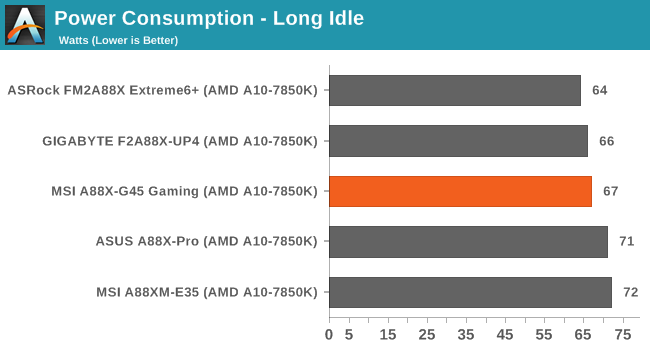
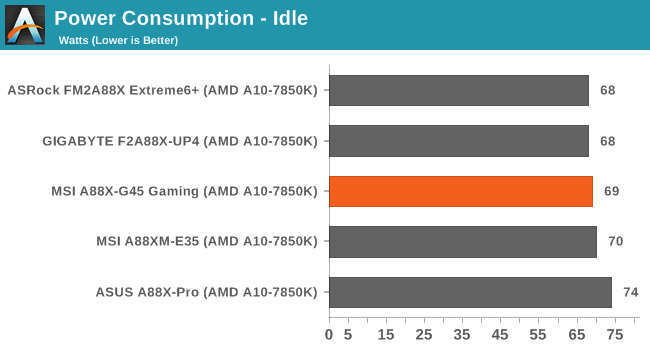
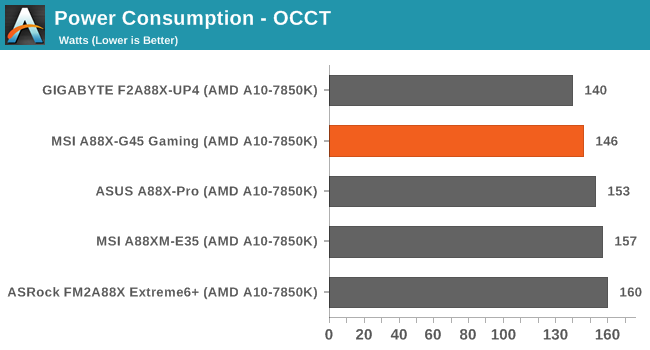
Both long idle and idle power consumption numbers are middle of the stack, but the peak power consumption gets under 150W unlike most of the rest.
Windows 7 POST Time
Different motherboards have different POST sequences before an operating system is initialized. A lot of this is dependent on the board itself, and POST boot time is determined by the controllers on board (and the sequence of how those extras are organized). As part of our testing, we are now going to look at the POST Boot Time - this is the time from pressing the ON button on the computer to when Windows 7 starts loading. (We discount Windows loading as it is highly variable given Windows specific features.) These results are subject to human error, so please allow +/- 1 second in these results.
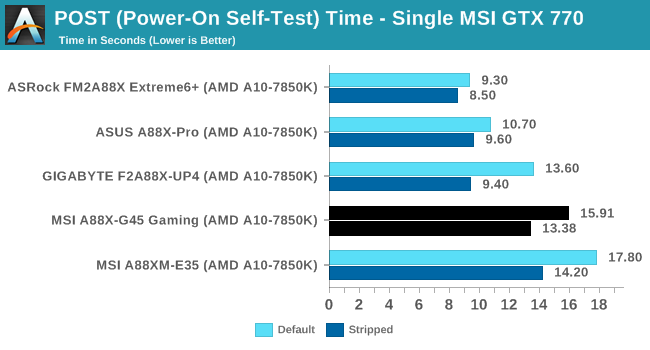
The POST times for the motherboard were not that exciting, showing that manufacturers are perhaps focusing more on their Windows 8 booting times instead.
Rightmark Audio Analyzer 6.2.5
The premise behind Rightmark:AA is to test the input and output of the audio system to determine noise levels, range, harmonic distortion, stereo crosstalk and so forth. Rightmark:AA should indicate how well the sound system is built and isolated from electrical interference (either internally or externally). For this test we connect the Line Out to the Line In using a short six inch 3.5mm to 3.5mm high-quality jack, turn the OS speaker volume to 100%, and run the Rightmark default test suite at 192 kHz, 24-bit. The OS is tuned to 192 kHz/24-bit input and output, and the Line-In volume is adjusted until we have the best RMAA value in the mini-pretest. We look specifically at the Dynamic Range of the audio codec used on board, as well as the Total Harmonic Distortion + Noise.
Dynamic Range for A88X-G45 Gaming
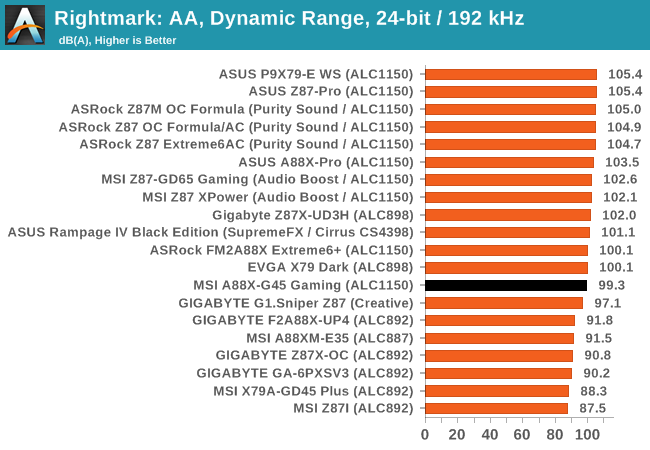
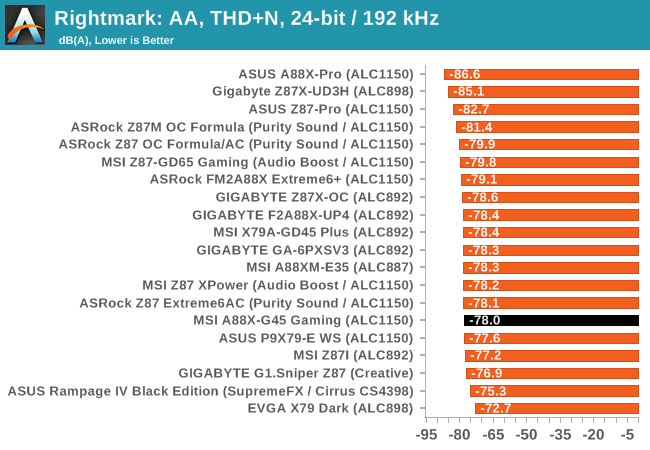
For an enhanced Realtek ALC1150 audio solution, the results from the motherboard were lower than expected. The dynamic range is our first ALC1150 under 100 dBA, and the THD+N has nothing on the A88X-Pro.
USB Backup
For this benchmark we transfer a set size of files from the SSD to the USB drive using DiskBench, which monitors the time taken to transfer. The files transferred are a 1.52 GB set of 2867 files across 320 folders – 95% of these files are small typical website files, and the rest (90% of the size) are the videos used in the WinRAR test. In an update to pre-Z87 testing, we also run MaxCPU to load up one of the threads during the test which improves general performance up to 15% by causing all the internal pathways to run at full speed.
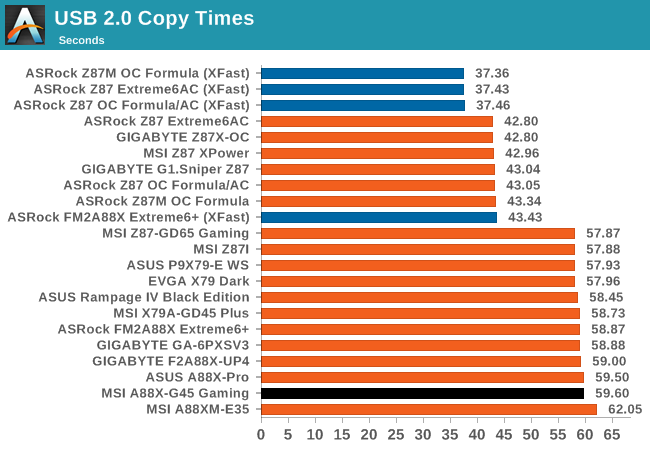
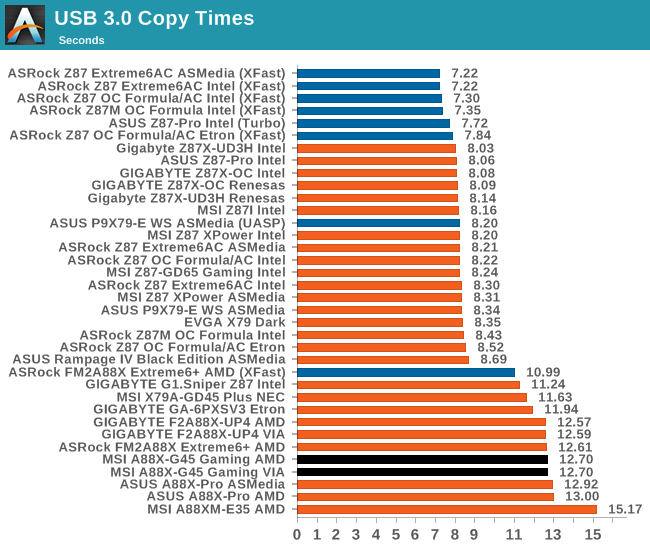
USB speeds were middle of the road, although it is interesting that at the bottom of the USB 2.0 list are two MSI motherboards. That being said the chipset and VIA USB 3.0 ports are both better than some of the competition.
CPU Benchmarks
Readers of our motherboard review section will have noted the trend in modern motherboards to implement a form of MultiCore Enhancement / Acceleration / Turbo (read our report here) on their motherboards. This does several things – better benchmark results at stock settings (not entirely needed if overclocking is an end-user goal), at the expense of heat and temperature, but also gives in essence an automatic overclock which may be against what the user wants. Our testing methodology is ‘out-of-the-box’, with the latest public BIOS installed and XMP enabled, and thus subject to the whims of this feature. It is ultimately up to the motherboard manufacturer to take this risk – and manufacturers taking risks in the setup is something they do on every product (think C-state settings, USB priority, DPC Latency / monitoring priority, memory subtimings at JEDEC). Processor speed change is part of that risk which is clearly visible, and ultimately if no overclocking is planned, some motherboards will affect how fast that shiny new processor goes and can be an important factor in the purchase.
Point Calculations – 3D Movement Algorithm Test: link
3DPM is a self-penned benchmark, taking basic 3D movement algorithms used in Brownian Motion simulations and testing them for speed. High floating point performance, MHz and IPC wins in the single thread version, whereas the multithread version has to handle the threads and loves more cores.


The MSI A88X-G45 Gaming finds the joint top spot of our single-threaded performance graph, and second in the multi-threaded version of the benchmark.
Compression – WinRAR 5.0.1: link
Our WinRAR test from 2013 is updated to the latest version of WinRAR at the start of 2014. We compress a set of 2867 files across 320 folders totaling 1.52 GB in size – 95% of these files are small typical website files, and the rest (90% of the size) are small 30 second 720p videos.

WinRAR is currently an Achilles heel with MSI A88X motherboards.
Image Manipulation – FastStone Image Viewer 4.9: link
Similarly to WinRAR, the FastStone test us updated for 2014 to the latest version. FastStone is the program I use to perform quick or bulk actions on images, such as resizing, adjusting for color and cropping. In our test we take a series of 170 images in various sizes and formats and convert them all into 640x480 .gif files, maintaining the aspect ratio. FastStone does not use multithreading for this test, and thus single threaded performance is often the winner.

65 seconds seems quite slow for an A88X model.
Video Conversion – Handbrake v0.9.9: link
Handbrake is a media conversion tool that was initially designed to help DVD ISOs and Video CDs into more common video formats. The principle today is still the same, primarily as an output for H.264 + AAC/MP3 audio within an MKV container. In our test we use the same videos as in the Xilisoft test, and results are given in frames per second.


While slightly behind in the small frame transcoding, the larger test puts all the A88X motherboards on the same level.
Rendering – PovRay 3.7: link
The Persistence of Vision RayTracer, or PovRay, is a freeware package for as the name suggests, ray tracing. It is a pure renderer, rather than modeling software, but the latest beta version contains a handy benchmark for stressing all processing threads on a platform. We have been using this test in motherboard reviews to test memory stability at various CPU speeds to good effect – if it passes the test, the IMC in the CPU is stable for a given CPU speed. As a CPU test, it runs for approximately 2-3 minutes on high end platforms.

The A88X-G45 Gaming comes almost at the top of our A88X motherboards tested.
Synthetic – 7-Zip 9.2: link
As an open source compression tool, 7-Zip is a popular tool for making sets of files easier to handle and transfer. The software offers up its own benchmark, to which we report the result.

Gaming Benchmarks
F1 2013
First up is F1 2013 by Codemasters. I am a big Formula 1 fan in my spare time, and nothing makes me happier than carving up the field in a Caterham, waving to the Red Bulls as I drive by (because I play on easy and take shortcuts). F1 2013 uses the EGO Engine, and like other Codemasters games ends up being very playable on old hardware quite easily. In order to beef up the benchmark a bit, we devised the following scenario for the benchmark mode: one lap of Spa-Francorchamps in the heavy wet, the benchmark follows Jenson Button in the McLaren who starts on the grid in 22nd place, with the field made up of 11 Williams cars, 5 Marussia and 5 Caterham in that order. This puts emphasis on the CPU to handle the AI in the wet, and allows for a good amount of overtaking during the automated benchmark. We test at 1920x1080 on Ultra graphical settings.
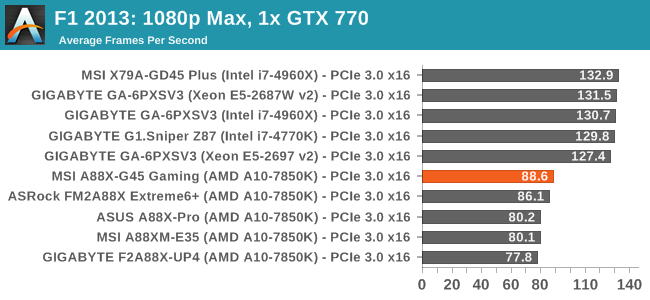
While behind all the Intel results, the A88X-G45 Gaming comes top of the AMD crowd.
Bioshock Infinite
Bioshock Infinite was Zero Punctuation’s Game of the Year for 2013, uses the Unreal Engine 3, and is designed to scale with both cores and graphical prowess. We test the benchmark using the Adrenaline benchmark tool and the Xtreme (1920x1080, Maximum) performance setting, noting down the average frame rates and the minimum frame rates.
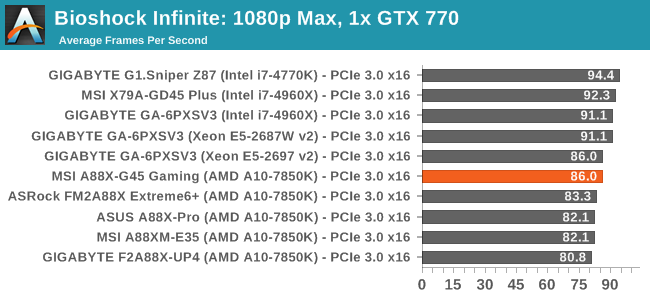
Again, another top of the AMD crowd for the MSI motherboard.
Tomb Raider
The next benchmark in our test is Tomb Raider. Tomb Raider is an AMD optimized game, lauded for its use of TressFX creating dynamic hair to increase the immersion in game. Tomb Raider uses a modified version of the Crystal Engine, and enjoys raw horsepower. We test the benchmark using the Adrenaline benchmark tool and the Xtreme (1920x1080, Maximum) performance setting, noting down the average frame rates and the minimum frame rates.
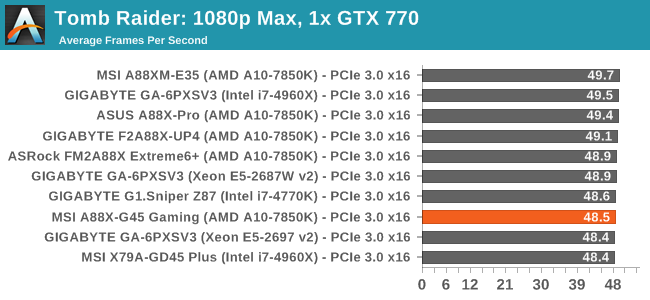
Tomb Raider seems fairly agnostic to motherboard and platform.
Sleeping Dogs
Sleeping Dogs is a benchmarking wet dream – a highly complex benchmark that can bring the toughest setup and high resolutions down into single figures. Having an extreme SSAO setting can do that, but at the right settings Sleeping Dogs is highly playable and enjoyable. We run the basic benchmark program laid out in the Adrenaline benchmark tool, and the Xtreme (1920x1080, Maximum) performance setting, noting down the average frame rates and the minimum frame rates.
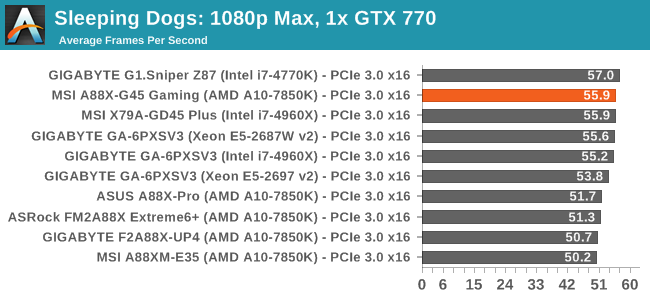
The A88X-G45 Gaming mixes it up with the Intel results, being clear of any other A88X motherboard.
Battlefield 4
The EA/DICE series that has taken countless hours of my life away is back for another iteration, using the Frostbite 3 engine. AMD is also piling its resources into BF4 with the new Mantle API for developers, designed to cut the time required for the CPU to dispatch commands to the graphical sub-system. For our test we use the in-game benchmarking tools and record the frame time for the first ~70 seconds of the Tashgar single player mission, which is an on-rails generation of and rendering of objects and textures. We test at 1920x1080 at Ultra settings.
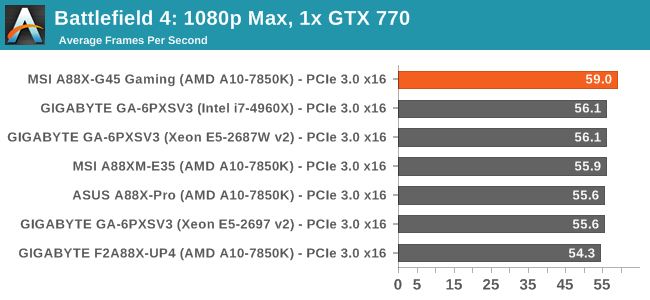
MSI A88X-G45 Gaming Conclusion
Any motherboard labelled as a gaming product has to do one thing well: gaming. If we go on benchmark numbers alone, our setup with the A88X-G45 Gaming puts this motherboard at the top or almost at the top of any of the A88X motherboards we have tested. Almost every gaming benchmark puts the MSI either on par with the top frame rates, or above by a few FPS.
The downside to this seems to be a relatively poor showing in our real-world CPU benchmarks. The MSI motherboard scores bottom or near bottom in most of them, often paired with our other MSI A88X review showing that while gaming efficiency seems to be high, CPU efficiency is not.
The overclocking performance is good out of the box, especially with OC Genie providing a nice 4.25 GHz of our A10-7850K CPU with a touch of a button. The manual overclocking also went well, showing 4.6 GHz before the system declocked due to temperatures. It should be noted that going for that high of an overclock will double the power draw for the CPU.
Another potential flaw with the gaming motherboard is the audio, which falls below other ALC1150 implementations in our tests. In my previous experience, this can change with as much as a driver update, so ensure that the drivers are the latest. Luckily MSI’s Live Update 6 software included with the driver DVD is some of the best around for making sure that the motherboard drivers and software is up to date. MSI needs to update the A88X BIOS to include some of the features it introduced in Z97, such as easy XMP support, ordered overclocking options and better fan controls.
MSI has positioned the A88X-G45 Gaming at $119/£89 (currently discounted to $105), which puts it around the high end for an FM2+ gaming motherboard. There are cheaper options available, though few are listed as specifically designed for the gaming community. There are some flaws with the overall performance, but for gaming where it matters MSI offer a good option for anyone investing in an AMD gaming platform.
MSI’s main competition comes from GIGABYTE’s A88X G1.Sniper gaming motherboard, ASRock’s A88X Killer and the recently announced ASUS ROG Crossblade Ranger. The MSI matches the ASRock for price, while the other two are either side ($105 for the GIGABYTE, $160 for the ASUS).

